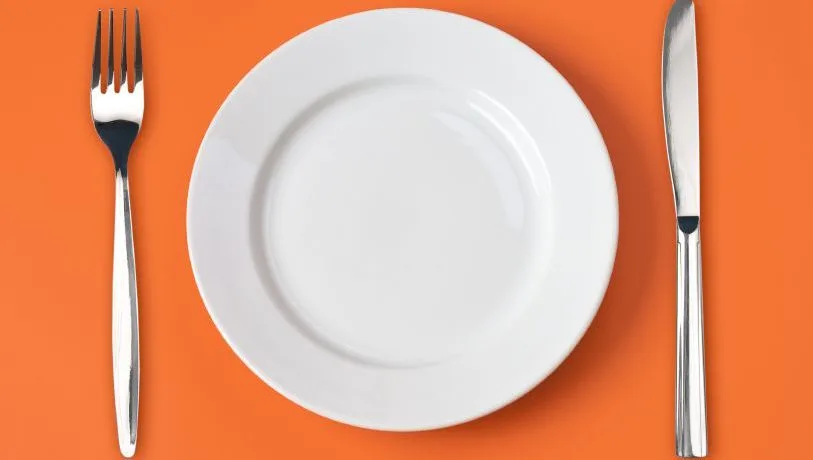Intermittent fasting has exploded in popularity over the past few years. Proponents claim it can help with weight loss, extend lifespan, and provide a host of other benefits. But does the science actually back up these bold assertions? In this post, we’ll explore the real scientific facts behind intermittent fasting for weight loss.

The Growing Popularity of Intermittent Fasting
Intermittent fasting (IF) has become one of the hottest diet trends. A Google Trends analysis shows online searches for the term have grown fivefold over the past five years. Thousands of people are joining IF support groups and online forums to share their experiences.
Celebrities like Hugh Jackman, Miranda Kerr, and Terry Crews have publicly credited IF for their shredded physiques. Silicon Valley biohackers like Peter Attia advocate fasting as a way to extend longevity and mental clarity. Podcast host Joe Rogan frequently interviews doctors and scientists about the benefits of fasting on his wildly popular show.
With all this hype, it’s no wonder people are eager to try intermittent fasting for themselves. Proponents claim it can help with weight loss, increase fat burning, reduce inflammation, improve focus, and extend lifespan. But what does the science actually say? Let’s dig in.
The Promise of Weight Loss Through Intermittent Fasting
The main reason people try intermittent fasting is to lose weight. And there’s certainly some evidence backing up this benefit.
Studies show IF can help people lose between 3-8% of their body weight over 3-24 weeks. That equates to 6-16 pounds for someone weighing 200 pounds. Some studies even report 7-13% weight loss over 6-12 months.
But weight loss results can vary widely. Some people lose a lot of weight with IF, others just a few pounds. Much depends on the specific protocol used, adherence, and individual factors.
Later in this post we’ll unpack the science explaining how intermittent fasting promotes fat burn and weight loss. First, let’s cover the basics of what intermittent fasting actually is.
Preview of Key Scientific Insights
Intermittent fasting provides a simple, scientifically supported framework for weight loss. But the details matter.
In this post, we’ll explore questions like:
- How does intermittent fasting achieve a caloric deficit to drive weight loss?
- What fasting protocols and meal timing strategies work best?
- How does IF affect appetite, metabolism, and body composition?
- What does the latest research reveal about efficacy and safety?
Let’s dig into the science and get answers.

The Basics of Intermittent Fasting
Intermittent fasting (IF) is an eating pattern that cycles between periods of fasting and normal eating. It doesn’t specify which foods you should eat, but instead dictates when you should eat them.
There are several different IF approaches, so it can be confusing. Let’s break it down step-by-step.
Defining Intermittent Fasting
Intermittent fasting simply means alternating intervals of fasting and normal eating.
Fasting generally means severe calorie restriction – consuming only water, black coffee, and tea. The normal eating periods involve eating normally with no major restrictions.
The most popular IF protocol is 16/8. This alternates 16 hours of fasting with an 8 hour eating window daily. For example, skipping breakfast and only eating from 12-8pm.
Some people fast for 24 hours 1-2 times per week. Others fast every other day. There are many different IF schedules.
The key is cycling periods of fasting with periods of normal or even increased food intake. This intermittent cycling is what provides unique benefits.
Different Approaches to Intermittent Fasting
Here are some of the most common intermittent fasting protocols:
- 16/8 method – Fast for 16 hours per day, eat during the other 8 hours. This generally means skipping breakfast and only eating from 12-8pm daily. Sometimes called time-restricted feeding.
- Eat-Stop-Eat – Do 24 hour fasts 1-2 times per week, eating normally otherwise. For example, fasting from dinner Monday night until dinner Tuesday night.
- 5:2 diet – Eat normally 5 days per week. Fast or drastically reduce calories for 2 non-consecutive days per week.
- Alternate day fasting – Alternate fasting days with normal eating days. Modified versions allow about 25% of normal calories on fasting days.
- Warrior diet – Eat small amounts of raw fruits and vegetables during the day. Consume one large meal at night.
There’s flexibility to choose a method that suits your lifestyle and preferences. The most important thing is sticking with a consistent fasting/feeding schedule.
The Physiology of Fasting
To understand how intermittent fasting leads to benefits like weight loss, we have to explore what happens inside the body when fasting.
Insulin and Its Role
Insulin is the key hormone released when we eat, helping cells absorb glucose and amino acids. But chronically high insulin levels can lead to insulin resistance.
Intermittent fasting gives the body a break from insulin. This increases insulin sensitivity and lowers insulin levels overall.
Enhanced insulin function helps regulate blood sugars, control hunger and cravings, and make stored body fat more accessible for energy.
Autophagy: Cellular Recycling
Autophagy is a process where cells recycle damaged components. Intermittent fasting triggers increased autophagy.
This self-cleaning process provides anti-aging benefits and prevents damaged cells and proteins from accumulating.
Hormonal Changes During Fasting
Fasting increases levels of human growth hormone (HGH), a hormone important for fat metabolism and muscle gain.
It also raises adrenaline and noradrenaline, which help break down fat.
Ketone bodies also start to increase, providing an alternative energy source for the brain. These hormonal changes prime the body to tap into fat stores.
The Link Between Fasting and Weight Loss
The metabolic and hormonal changes that occur during intermittent fasting make it easier for the body to shift into fat burning mode. Let’s explore the science on how IF can promote weight loss.
Caloric Restriction vs. Fasting
Weight loss ultimately comes down to being in an energy deficit – burning more calories than you consume. Intermittent fasting provides a simple way to achieve this deficit without consciously restricting calories.
Some benefits seem unique to fasting vs just daily caloric restriction. However, weight loss results are similar in the two approaches.
Metabolic Changes
Several small studies show intermittent fasting increases resting metabolic rate by 3-14%.
This means the body burns slightly more calories at rest, further contributing to a caloric deficit.
The metabolic boost seems to be caused by increased levels of noradrenaline and adrenaline during the fasting periods.
In summary, intermittent fasting facilitates weight loss by lowering insulin, increasing fat burning hormones, providing an outlet for fat mobilization, and slightly boosting resting metabolism.

The Science Behind Weight Loss
Now that we understand some of the biology behind intermittent fasting, let’s zoom out and talk about the broader science of weight loss.
The Caloric Deficit Principle
At its core, weight loss depends on being in an energy deficit – taking in fewer calories than you burn. Intermittent fasting provides a simple way to create this deficit.
Creating a 500 calorie daily deficit yields about 1 pound lost per week. A 1000 calorie deficit equals 2 pounds per week. Very low calorie diets provide larger deficits for faster initial loss.
But an overly aggressive deficit can be hard to maintain and negatively impact metabolic rate and lean mass loss. Moderation is key.
Role of Fasting in Achieving a Caloric Deficit
Intermittent fasting restricts eating to set windows during the day or week. This automatic deficit often leads to weight loss without consciously limiting calories.
Some benefits seem unique to fasting, but overall weight loss results are similar to daily caloric restriction.
Impact on Body Composition
Along with fat loss, some studies show intermittent fasting causes 3-9% loss of lean mass over 3-12 months.
This modest lean mass loss is common with weight loss. But higher protein intake, strength training, and gradual weight loss can help preserve muscle.
Key Studies and Research Findings
Dozens of human clinical trials have explored intermittent fasting for weight loss. Here’s a high level look at some of the evidence.
Clinical Trials on Weight Loss
- 16/8 fasting resulted in 7% weight loss over 12 months compared to no change in controls.
- Alternate day fasting led to 6% weight loss over 12 months versus no change for controls.
- Ramadan fasting caused 2-5% weight loss in studies, but weight was often regained afterwards.
- Systematic reviews show intermittent fasting typically leads to 3-8% weight loss over 3-24 weeks.
So we can conclude intermittent fasting generally provides modest but meaningful long-term weight loss of around 3-9% in trials.
Long-Term Health Benefits
Beyond just short-term weight loss, some research indicates intermittent fasting could provide other health benefits:
- Decreased inflammation markers
- Improved insulin sensitivity and blood sugar regulation
- Increased longevity in animal studies
However most of these other benefits need more research in humans to confirm. Weight loss remains the main proven application.
Intermittent Fasting Protocols
Now that we’ve covered the science let’s get practical. Here are some of the most popular styles of intermittent fasting along with pros and cons.
Popular Fasting Methods
There are many ways to implement intermittent fasting. The best approach depends on your lifestyle preferences and goals.
16/8 Method
The 16/8 method involves fasting for 16 hours per day, and restricting food intake to an 8 hour window.
Pros: Simple and flexible. Allows you to eat everyday. Aligns with natural circadian rhythms.
Cons: May be harder for some people to fast for 16+ hours daily.
5:2 Diet
This approach involves eating normally 5 days per week, and fasting or restricting intake to ~500 calories for 2 non-consecutive days per week.
Pros: Less frequent fasting periods. Easier for socializing on weekends.
Cons: Fasting days are more intense. Requires careful planning.
Eat-Stop-Eat
Doing 1 or 2 complete 24 hour fasts per week, such as dinner to dinner or breakfast to breakfast.
Pros: Less frequent fasting periods. Some find 24 hour fasts energizing.
Cons: Avoid back to back 24 hour fasts. Difficult for some people.
Alternate Day Fasting
Fasting or restricting calories every other day. Modified versions allow ~25% of normal intake on fasting days.
Pros: Maximizes metabolic benefits of fasting. Promotes weight loss.
Cons: Most difficult method. Not suitable as ongoing lifestyle.
While these are the most studied protocols, there are many other variations including warrior diets and periodic 3-7 day fasts. The best approach depends on your goals and personal preferences. Experiment to find what works for you.
Choosing the Right Method for You
Here are some factors to consider when selecting an intermittent fasting protocol:
- Daily Routine – Pick a method that fits with your schedule. For example, fasting after dinner works for many people.
- Social Life – If you have events on weekends, consider a 5:2 style schedule.
- Goals – More frequent and longer fasts tend to promote more weight loss.
- Lifestyle – Find an approach that’s sustainable long term, not just a quick fix diet.
Be flexible and don’t be afraid to adjust your fasting periods and styles over time. Consistency is what matters most.
Common Pitfalls to Avoid
Here are some common mistakes that can sabotage your intermittent fasting success:
- Changing fasting schedule frequently
- Eating too many calories during eating window
- Choosing empty calorie foods when breaking fast
- Not staying hydrated during fasting period
- Skipping workouts during fasting period
- Going too long between fasting periods
- Quitting IF after short term
The most important things are sticking to your chosen fasting/feeding schedule, eating healthy whole foods, exercising, and staying hydrated.

Meal Planning and Nutrition During Fasting
To get the most out of intermittent fasting, optimize your nutrition during your eating window.
Making Healthy Food Choices
Focus on eating whole, minimally processed foods like lean proteins, healthy fats, fruits, vegetables, and high fiber carbohydrates. Avoid added sugar and refined grains.
Meal composition can remain the same as usual. Just focus those meals into your shortened eating window. No need to force small frequent meals.
Nutrient Timing
Try front-loading your food intake with larger meals early during the eating window. This provides energy and nutrients to fuel your day.
Having a smaller final meal before the fasting period starts again can ease the transition.
Hydration and Fasting
Stay well hydrated with water, unsweetened tea, and coffee. Add a pinch sea salt to water to replenish electrolytes.
Avoid sugar-sweetened beverages which can trigger hunger and cravings.
Combining Fasting with Specific Diets
Intermittent fasting provides a schedule for eating. You can combine it with different meal plans:
- Mediterranean diet – Emphasizes healthy fats, seafood, fruits/veggies
- Paleo diet – Focuses on meat, fish, eggs, fruits, veggies, nuts
- Low carb diet – Limits refined carbs and emphasizes protein, fat instead
The most important factor is choosing a meal plan you can sustain in a healthy way long term.
Overcoming Challenges and Safety Considerations
Changing your eating pattern with intermittent fasting takes some adjustment. Understand how to overcome hurdles and stay safe.
Potential Side Effects
When first starting out with fasting, some people report:
- Hunger and cravings (especially at previous mealtimes)
- Low energy and irritability
- Headaches
- Constipation
These initial symptoms often improve within 1-2 weeks as the body adapts. Staying hydrated can help counter headaches and constipation.
Addressing Hunger and Cravings
To reduce hunger and cravings during the fast, consider:
- Drinking water, tea, or coffee
- Keeping busy and avoiding food-centric situations
- Brushing teeth to stop cravings
- Going for a walk or doing other light exercise
- Waiting 20 minutes to see if hunger passes
If intense hunger persists, you may need to adjust your fasting regimen or seek medical advice.
Who Should Avoid Intermittent Fasting
Intermittent fasting is not advisable for some populations. You should NOT fast if you:
- Are underweight, malnourished, or have nutritional deficiencies
Thank you for reading this post, don't forget to subscribe to our free newsletter
!
